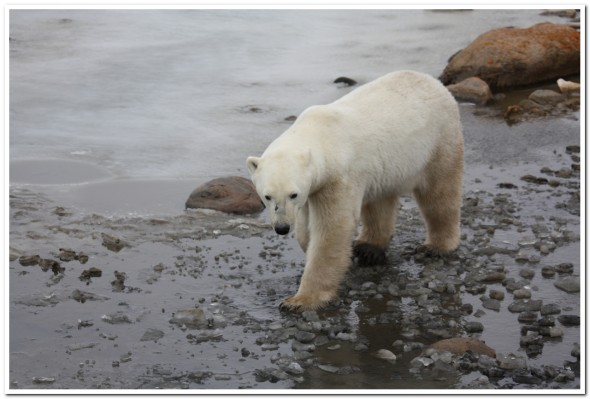 This is a guest post by Dr. Gregory Thiemann, an Assistant Professor in the Faculty of Environmental Studies at York University. Greg is a polar bear expert that I met in Canada recently when we both worked with Polar Bears International on their Tundra Connections project.
This is a guest post by Dr. Gregory Thiemann, an Assistant Professor in the Faculty of Environmental Studies at York University. Greg is a polar bear expert that I met in Canada recently when we both worked with Polar Bears International on their Tundra Connections project.
As I write this, I’m on a Calm Air flight enroute to Winnipeg from Churchill, MB. I have spent the last six days volunteering for Polar Bears International, working alongside other scientists, educators and advocates to communicate the status of polar bears and the conservation threats posed by anthropogenic climate change.
Churchill is located at the ecotone of the boreal forest to the south and the open tundra to the north. It is also widely known as the “polar bear capital of the world”. The primary habitat of polar bears is sea ice, but every summer, as the ice melts on Hudson Bay, the entire Western Hudson Bay subpopulation of polar bears comes ashore near Churchill. Adult male polar bears often distribute themselves along the coastal flats, while adult females with cubs head farther inland, presumably to avoid potentially dangerous males. Pregnant females also move inland, reaching the maternity denning area within the boreal forest. The roots of stunted spruce trees on riverbanks and lakeshores provide structure to the earthen dens that polar bears dig down to the permafrost. Once the den is drifted over with snow, the bear and her cubs move into a new snow den where they stay until spring.
Depending on the timing of ice breakup in the summer and freeze-up in the fall, individual polar bears in this subpopulation will spend 4-5 months on shore. During this period, the bears have little access to their marine mammal prey and are forced to rely on their stored fat for energy. When most of the bears return to the sea ice in late fall, pregnant females remain in their dens, giving birth to and nursing their cubs over the next 4 months. This 8-9 month “reproductive fast” illustrates the polar bear’s amazing resilience and adaptability. But as warming temperatures extend the ice free season, these physiological abilities are being pushed to their limits.
A recent study by Steven Amstrup and his colleagues revealed that the declining Arctic sea ice has not yet reached a “tipping point”. That is, if greenhouse gas emissions were reduced, the climate would cool and polar bear sea ice habitat would recover. This is great news for the conservation of polar bears, and all pagophilic (ice loving) species. But the ice-climate system is not the only arena in which tipping points could impact polar bears.
Working with polar bear biologist Andrew Derocher at the University of Alberta, Peter Molnar found that potential Allee effects could negatively affect the reproductive success of polar bears. Specifically, if the operational sex ratio (i.e., the number of males versus the number of females available for breeding) declined below a certain threshold, female mating success would decline precipitously. There would simply be too few males to inseminate the females. This is of concern for two big reasons: 1) warming temperatures may fragment sea ice habitat during the spring breeding season and make it more difficult for polar bears, already at low density, to find each other; and 2) polar bear management in Canada relies on a male-biased quota system that aims to harvest two male bears for every one female. This effectively reduces the operational sex ratio.
Molnar’s work also identified other potential tipping points in polar bear population dynamics. For instance, if the ice-free onshore period for polar bears in Western Hudson Bay is extended to 180 days (about 7 weeks longer than current conditions), there would be mass starvation. This is especially worrisome because Molnar et al.’s calculations were based on physiological data from adult male bears, which are certain to be the least vulnerable to starvation. Large-scale mortality of juvenile bears, which have smaller absolute fat stores, will likely occur much earlier.
One of the clearest links between polar bear habitat and demography is via reproduction, and there’s a tipping point there, too. When pregnant females have less time on the ice, they come ashore in poorer condition and are less likely to endure their reproductive fast and produce large litters of healthy cubs. A linear decline in polar bear reproduction was identified by Stirling et al. back in 1999. More recently, Molnar et al. (2011) concluded that if polar bears in Western Hudson Bay were forced to come on shore in early June (about one month earlier than in 2011), the subpopulation would experience complete reproductive failure.
The fact that people still have the power to mitigate climate warming and restore declining sea ice habitat is reason for optimism. But when attempting to make projections for conservation, we need to keep in mind that the effects of climate change are often non-linear and stochastic. We don’t need to see gradual deterioration for populations to collapse and species to go extinct. Rather, in some cases, all it will take is one bad year. With continued environmental degradation, we are pushing countless systems to the edges of unidentified thresholds, and effectively increasing the probability that this may be that one bad year.

Leave a Reply